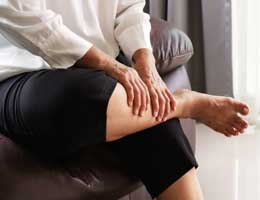
Varicose veins are swollen or dilated veins that appear as soft, bluish lumps just under the skin. They occur most often in the legs. Besides causing many people to feel self-conscious about their appearance, they may cause other problems, including:
- Aching or a feeling of heaviness in the legs.
- Poor circulation to the lower legs, which can lead to dry, itchy, scaly or darkened skin above the ankles that's easily injured and infected.
- An increased risk of blood clots and poor circulation throughout the legs.
- Persistent pain, redness, warmth or swelling.
- In rare cases, a blood clot in the leg may break loose and travel to the lungs, causing a pulmonary embolism. This is a medical emergency.
What goes wrong
Arteries carry blood from the heart to the organs and veins carry the blood back to the heart.
To complete this cycle, blood flow has to fight gravity sometimes, especially while returning from the legs to the heart. To aid this process, the veins in the legs have several one-way valves. These valves open as the blood moves upward and then close, preventing the blood from flowing back down.
When a valve doesn't work properly, blood flows backward, building up against the next lowest valve. The extra weight and volume weakens this valve until it, too, stops working properly. This continues to happen until all of the valves in a section of the vein break down. The vein then bulges under the weight and pressure of the extra blood.
Who do they happen to?
Varicose veins occur in women more often than in men, according to the American Academy of Family Physicians (AAFP). Risk factors include:
- Heredity.
- Pregnancy.
- Being overweight or obese.
- Standing or sitting for long periods, particularly for more than four hours at a time.
- Older age.
Can they be prevented?
The AAFP and the Office on Women's Health offer this advice for reducing your risk of varicose veins:
- Avoid standing or sitting for long periods of time. Make sure to walk around every half hour. Moving the muscles in your legs helps pump blood upward.
- Wear loose clothing.
- Try not to sit with your legs crossed.
What about treatment?
To reduce the pain, swelling and complications of varicose veins, it may help to:
- Raise the legs when sitting.
- Wear custom-fitted support stockings.
- Lose weight if you're overweight.
- Exercise regularly.
A doctor may treat varicose veins using:
- Surgical ligation and stripping, surgery that ties a varicose vein closed and uses a special instrument to remove part of the vein.
- Ambulatory phlebectomy, surgery that uses tiny incisions to remove varicose veins.
- Radiofrequency or laser ablation, a procedure that uses radiofrequency or laser energy to heat a vein from the inside out, causing the vein to collapse and seal shut.
- Sclerotherapy, a procedure that uses a medication that is injected directly into the varicose vein. The medication makes the vein walls swell, stick together and seal shut.
The right treatment depends on several factors, such as the size, type and number of veins being treated. In many cases, people can resume normal activities the day after the procedure.
Though individual veins can be treated, you'll still be prone to developing more varicose veins.
Reviewed 8/14/2023